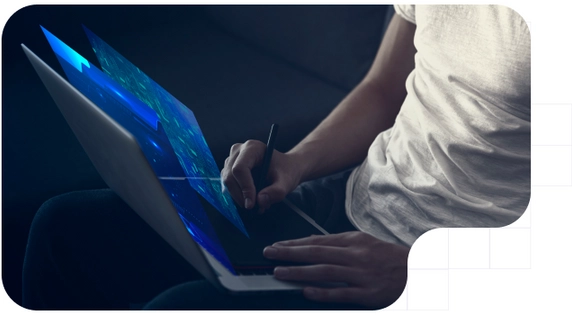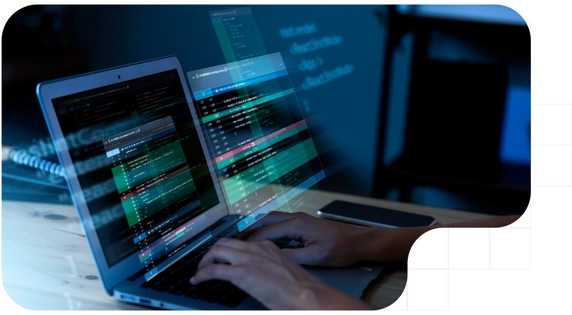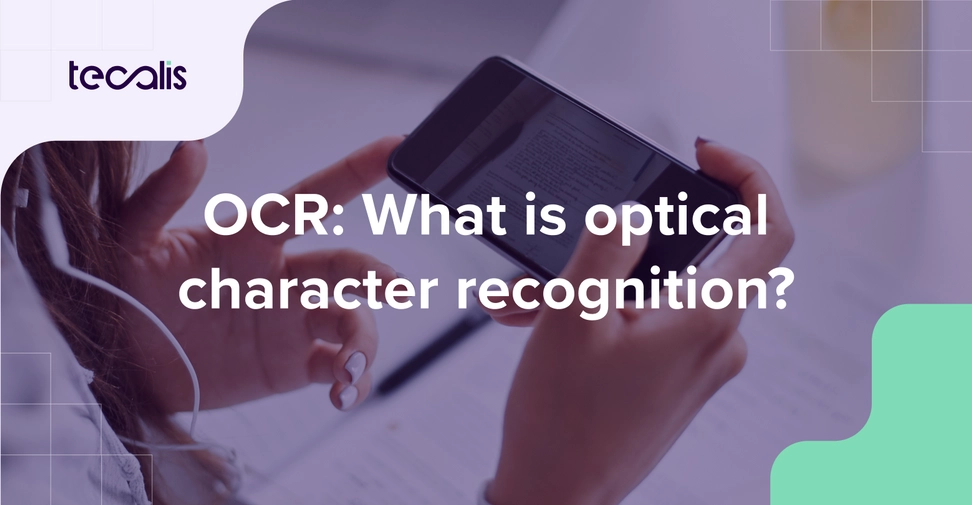Index
Get the latest news right in your inbox
Text is the main element we work with on a daily basis and OCR is one of the allies to speed up this burden. When we come across non-editable (and non-selectable) text, it seems that we have no choice but to rewrite it "by hand", however, OCR technology can help us do this in seconds and without errors.
Today, the possibilities offered by tools using artificial intelligence are virtually limitless, and optical character recognition (OCR) was not to be left behind. This computer technology is of growing interest to both individual users and businesses as we move closer to a zero-paper world.
In this article, we will explain in detail what OCR is, how it works, the different types of OCR systems available, as well as the best free applications for both users and businesses. We will also examine specific use cases for OCR in enterprise environments and highlight other related systems that complement this technology.
What is OCR (Optical Character Recognition)?
OCR (Optical Character Recognition) is a computer system for digitizing text. The purpose of these software programs and applications is to convert images and other non-indexable files containing textual information from scanned, camera-captured or non-editable formats of all kinds to extract editable text files. It uses advanced algorithms to recognize and analyze character patterns in an image and then convert them into digitizable text, regardless of the typeface or calligraphy used.
OCR is essentially an automation tool that allows users and companies to process large quantities of documents efficiently and accurately. In short, this process transforms images into data that can be analyzed, processed, processed, stored and searched efficiently.
How OCR works: image to text conversion
An OCR functions as a digital "translator" that interprets the shapes of letters, numbers and symbols present in an image and identifies them among "noise", converting them into characters that machines can understand.
The operation of OCR involves several steps. First, the system acquires an image of a document, either by scanning it, capturing it with a camera, or by collecting a non-text digital file. It then uses pattern recognition algorithms to identify and distinguish between individual characters in the image.
OCR algorithms use binarization and characterization to start the recognition process. They are based on three IPA principles: completeness, intencinoality and adaptivity. Not all are capable of doing so, but second generation OCRs based on zonal ORC support adaptive and reconstruction technologies that allow information to be extracted, created, processed and readapted for various uses.
After this, OCRs fragment and segment the images in order to create histograms of the images (in mode determinations or clustering) and thin the components to be analyzed independently by comparing them with the patterns according to the different methods (geometric, statistical, structural, neuromimetic, Markovian or Zadeh). The process is similar for handwritten text recognition (where ICR tends to be used) and typed text recognition.
Once the characters are recognized, OCR converts them into editable text by matching them to a database of known character shapes. This process may involve analysis of character layout and consideration of context to improve conversion accuracy. In addition, the best OCR systems and tools are capable of understanding the layout of individual blocks of text, giving logic to their location on a canvas and hierarchizing them, well beyond exporting them as simple ASCII text. They can also format (bold, italics, underlines, lists, tables, diagrams, etc.). The OCR process is based on a series of basic steps:
- Image acquisition: The image can come from a scanner, camera, or from a cell phone or computer.
- Preprocessing: Image quality is improved to facilitate recognition by adjusting contrast, brightness and eliminating noise.
- Identification: Location and location of text within the input file.
- Segmentation: The image is divided into individual characters.
- Characteristic extraction: The characteristics of each character, such as shape, size and texture, are analyzed.
- Recognition: The extracted features are compared with a database of known character patterns.
- Post-processing: Any recognition errors are corrected and the resulting text is formatted.
Processing: This step is optional and can be of many types, with the user or the company deciding how it analyzes and for what purpose it uses the information extracted in an intelligent and automated way.
Types of OCR systems
There are several types of OCR available, each with its own specific features and applications. The main types include basic OCR, advanced OCR and machine learning OCR. Basic OCR is suitable for converting simple documents with a clear structure, while advanced OCR is capable of handling more complex documents with varied layouts and multiple fonts. On the other hand, machine learning OCR uses artificial intelligence techniques to improve character recognition accuracy through training with large data sets.
We find different types of OCR systems that we can also categorize according to the technology they use:
- Pattern-based OCR: This type of OCR compares image features against a database of predefined patterns. It is the simplest and least accurate method.
- Word OCR: It is similar to the previous one but it tries to work on the understanding of the elements with whole words instead of individual characters.
- Neural network-based OCR: This type of OCR uses artificial neural networks to learn to recognize characters. It is more accurate than pattern-based OCR, but requires a larger amount of data to train the neural network.
- Intelligent OCR: This type of OCR combines traditional OCR techniques with artificial intelligence and machine learning to improve recognition accuracy. It is also referred to as IRC for Intelligent Character Recognition. It can recognize different fonts, document formats and even process data based on the languages detected.
Finally we find another way to categorize the types of OCR by the usage model or the way the user accesses it. We find online OCR applications that work through a website where we upload a document and it returns a text box. Useful but with few possibilities. On the other hand we have the integrated tools of the operating systems themselves, oriented to help users.
For professional use, the enterprise OCR systems developed by RegTech partners in SaaS model stand out. Similarly, these technology providers also adapt these systems to the needs of business customers by integrating this technology through APIs for various use cases in multiple industries, which are described below.

The best free OCR applications for users
For individual users looking for affordable and easy-to-use OCR tools, there are several free applications available on the market. Some of the best options include Adobe Scan, CamScanner and Google Keep. These applications offer basic OCR functions, such as converting images to text and editing scanned documents like a basic text editor.
PDF documents, images and OCR text in Windows
In the Windows environment, there are several built-in and third-party options for OCRing PDF documents, images and text. Microsoft Office, for example, offers OCR capabilities in Word and OneNote, allowing users to convert text images into editable documents with some reliability.
Windows 10 and 11 incorporate an integrated OCR in the Photos application and in Snippets. With this tool, you can easily convert images to text.
OCR software to convert documents on MacOS
In the MacOS ecosystem, users can take advantage of built-in tools such as Preview and Automator to perform OCR on PDF documents and images. In addition, third-party software such as Readiris and PDFpen offer easy OCR functionality for Mac users.
Image to text and OCR recognition on Android & iOS
In mobile devices we find more and more native options as operating system functionality that allows us to recognize searchable text and copy it for further editing. These include Google Lens, integrated into Google Search, which allows us to identify objects, translate languages and extract text from images, Text Scanner (OCR), which integrates the system for scanning documents, receipts, business cards and converts images to text, and Microsoft's Office Lens, ideal for converting documents to PDF, Word or PowerPoint.
In iOS for iPhone and iPad we can find the Notes tool, Apple's native notes application that includes an integrated OCR.
Best OCR systems for businesses
In all companies we see how there are dozens of information-related workflows that work with data and text, especially in business operations and everything related to customer, finance, accounting and human resources. Apart from the basic functionalities that individual users need on a daily basis, the importance of OCR in companies is focused on extracting, understanding and categorizing the different information collected and knowing what type of document it is: an electronic invoice, a contract, legal documentation, forms, identity documentation, a deed, etc.
Previously, there were departments dedicated to manually handling and intervening in processes related to data collection, storage and processing. In many other cases, employees from different business areas of a company invested a considerable percentage of hours in this type of tasks, even though it was not their main activity but a direct consequence of their tasks and workflows.
For companies looking for robust and scalable OCR solutions, there are several systems available on the market that offer advanced OCR capabilities, as well as additional features such as document recognition and validation, integration with document management systems, and automation of business processes of all types using RPA (Robot Process Automation) technology.
Second generation OCR: document recognition and validation
Second generation OCR goes beyond the simple conversion of images to text and focuses on the recognition and validation of complete documents with data processing associated with the recognition of other elements in the inputs. These systems use advanced natural language processing and machine learning techniques to understand the content and context of documents, allowing for greater accuracy in recognition, processing and information extraction.
Tecalis provides systems that allow both structured and unstructured data to be processed with Zonal OCR. Second-generation OCR makes it possible to verify the authenticity of documents such as invoices, IDs and passports without the need to specify the type of document in advance.
Relevant document data, such as names, dates, addresses and numbers, can be automatically extracted and stored in a structured format. In addition, the technology incorporates dozens of anti-fraud checks that make it possible to assess that the documentation provided is not forged or altered. These include, for example:
- NFC reading.
- Serial number of the bracket.
- Reading and validation of the MRZ connecting with public and private databases.
- CLI and bas-reliefs.
- Die-cutting and embossing in high relief. Safety offset backgrounds.
- Integrity of the microchip and other elements.
- Watermarking, extraction of non-textual elements such as images, logos, etc.
- Recognition and validation of holograms.
- Natural shines and reflections, textured material.
- Optically variable inks and UV inks.
- Laser engravings on transparent window.
- Depth scale and three-dimensional environment.
- Daylighting controls.
- Security backgrounds and microtexts.
- Kinegram.
- Alignment of text and elements. Sharpness and color.
- Extraction and verification of handwritten signature, if any.
These are just a few basic examples of what is checked beyond text. On the other hand, unstructured data that is not in a predefined format, such as images, PDF documents and e-mails, is interpreted with predefined logics to prepare it for rapid subsequent use. Second-generation OCR can convert this unstructured data into structured data, making it easier to store, analyze and use.
OCR use cases in companies
OCR has a wide range of applications in enterprise environments in all areas (customer, back-office, human resources, finance, compliance, risk, etc.), from process automation to document management and improving operational efficiency. Some common use cases include:
Digital Onboarding
Used to digitize and process ID documents and forms during the onboarding process of new employees, customers and companies, associating it with identity verification and KYC controls. OCR is used to automate the verification of identity documents and the extraction of customer data during the online or face-to-face onboarding process. Address verification, age verification, AML and other associated systems are also included.
Automated matching, powers of attorney and KYB
Facilitates the verification and validation of legal documents, such as powers of attorney and contracts. Powers of attorney can be digitized and validated by OCR, streamlining the document management process and facilitating the Know Your Business process.
Documentation processing
It allows the automatic extraction of data from business documents, such as invoices and application forms, for further processing and analysis. This Optical Character Recognition (OCR) technology is especially used for Due Diligence processes of customers, companies, suppliers, etc. OCR can automate the extraction of invoice data, such as supplier, amount and date, simplifying accounting and expense control, among many other applications.

Banking, telecommunications, utilities, real estate, health and logistics
The use of Optical Character Recognition (OCR) in various industries has significantly transformed business processes, offering a wide range of benefits and advantages. In addition to the previously mentioned sectors such as banking, healthcare and logistics, other industries such as real estate, telecommunications, insurance and utilities have also benefited from this innovative technology.
In the real estate industry, OCR has been instrumental in streamlining the management of documents related to real estate transactions, leases, deeds and other legal documents. For example, real estate agencies use OCR to digitize and process leases, property IDs and other legal documents efficiently. This not only speeds up the transaction process, but also reduces errors associated with manual data entry, thus improving accuracy and customer satisfaction.
In the telecommunications industry, OCR is used to manage service contracts, invoices, customer records and other documents related to the provision of telecommunications services. For example, telecommunications companies use OCR to automatically scan and process customer invoices, which streamlines the billing process and reduces associated administrative costs. The best OSS/BSS systems such as Customer Hub include this system.
The insurance industry benefits from OCR to process and manage insurance claims, policies, certificates and other industry-related documents. For example, insurance companies use OCR to digitize and process claim forms automatically, which speeds up the claims settlement process and improves the customer experience.
In the utilities industry, OCR is used to manage utility bills, service contracts, meter readings and other documents related to utility service delivery. For example, utilities use OCR to automatically scan and process bills, which streamlines the billing process and reduces associated administrative costs.
Tecalis offers a range of services that can help companies implement and make the most of OCR in their daily operations.
Tecalis KYB and OCR uses machine learning (ML) and OCR to automatically extract text, handwriting and data from scanned documents such as PDF files and their full validation according to market and industry standards. With the ability to read thousands of different documents in various layouts and formats at high speed, this service provides an efficient and accurate solution for document management.
Tecalis offers APIs that allow text to be extracted from images and videos, making it easy to extract information from visual sources such as traffic signs, social media posts and product packaging. This large-scale image and video processing capability can significantly improve human visual review tasks with artificial intelligence, thereby increasing operational efficiency.
In banking, we see how they are used for dozens of fraud prevention processes and to improve the security of transactions such as eIDAS, among many other applications in the industry as we have seen previously. In the healthcare sector, hospital records, medical records, health questionnaires, informed consents, etc. are processed. Finally, in logistics and supply chain, OCR records and tracks package label tracking, receipts and digital invoice processing.
Other OCR-related systems
In addition to OCR, there are other related systems that complement this technology and extend its capabilities. These include optical recognition of non-textual elements such as trademarks, logos, watermarks, symbols, images, vehicle license plates... Likewise, there are RegTech applications that combine this technology and expand its use, giving rise to a wide variety of use cases and new opportunities for businesses.
- Electronic signature: Used to sign documents digitally and securely, it complements OCR by allowing the validation and authentication of electronic documents.
- Data collection: Enables automated data collection from scanned or digitized documents, facilitating data-driven analysis and decision making.
- Fraud and risk analysis: Uses advanced analysis techniques to detect patterns and anomalies in documents and transactions, helping to prevent and mitigate fraud and business risk.
- Anti-fraud controls: Implements security and validation measures to protect against fraudulent activity, including identity verification and counterfeit document detection.
- Customer Hub: Enables the automation and digitization of dozens of point-of-sale processes in businesses of all types, but especially in banking, insurance and telecommunications.
Its ability to convert unstructured data into useful information opens up a world of possibilities for process automation, efficiency improvement and strategic decision making. By combining OCR with other related systems, organizations can take full advantage of this technology to optimize their operations and achieve improved performance.

Benefits and advantages of using OCR
The use of Optical Character Recognition (OCR) systems offers a wide range of benefits and advantages for both individual users and businesses. These benefits include:
- Process automation: OCR systems automate data entry by converting physical documents into editable digital formats. This significantly reduces the time and resources required for manual data entry.
- Improved accuracy: Unlike manual data entry, which can be subject to human error, OCR provides much higher accuracy in character extraction and recognition. This helps minimize errors and ensures data integrity.
- Cost savings: By reducing the need for manual labor for data entry tasks, OCR systems help companies save on operational costs and employee time. In addition, by eliminating human error, potential costs associated with error correction are avoided.
- Increased efficiency: By processing large volumes of documents quickly and accurately, OCR systems increase operational efficiency. This enables companies to process information faster, reduce processing times and make data-driven decisions more quickly.
- Quick access and search for information: By converting physical documents into digital files, OCR facilitates quick access and search for information. Users can search for keywords or specific phrases within digitized documents, speeding up the retrieval of relevant information.
- Integration with existing systems: OCR systems are typically compatible with a variety of existing systems and applications, making them easy to integrate into the business workflow for all types of customer-related processes or internal business operations. This allows companies to make the most of their existing technology investment.
- Increased data security: When scanning physical documents, OCR helps improve data security by reducing the risk of document loss or theft. In addition, OCR systems often offer encryption and data protection options to ensure the security of sensitive information.
- Facilitates regulatory compliance: In many industries, such as finance, telecommunications and legal, there are strict regulatory compliance requirements for document management and storage. OCR systems facilitate compliance with these regulations by enabling more efficient and accurate document management.
In summary, the use of OCR systems provides a number of significant benefits, ranging from process automation and cost savings to improved data accuracy and security. By taking advantage of these benefits, companies can optimize their operations and improve their competitiveness in the marketplace.
























